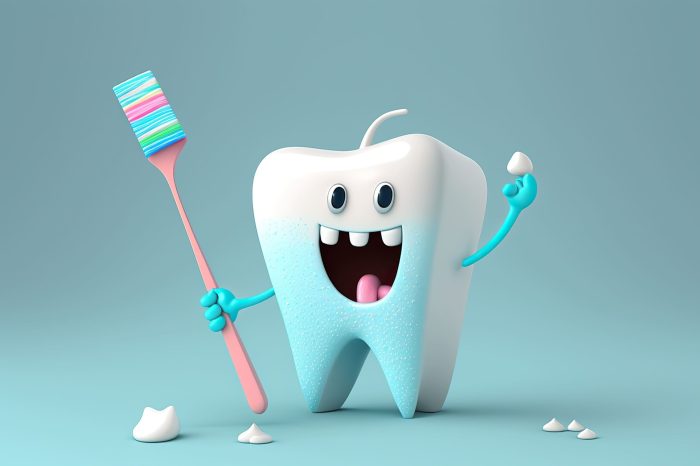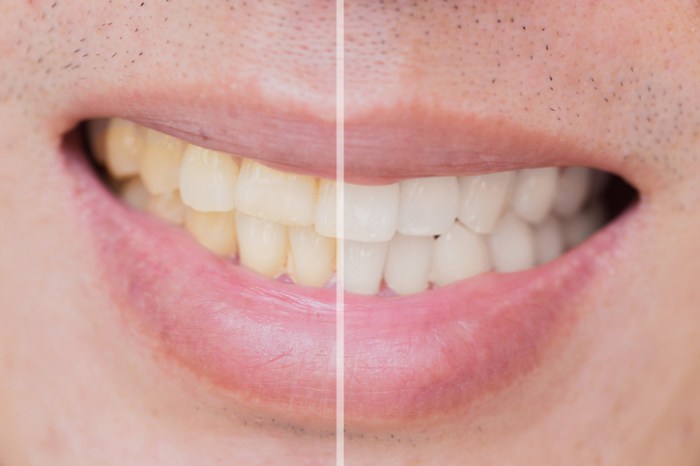Factors Affecting Tooth Staining from Food Coloring

Will food coloring stain teeth – Wooo! Let’s dive into the juicy details of how food coloring affects our pearly whites! It’s not just about the color, Adoh! There’s a whole science behind it, and it’s way more interesting than you might think. We’ll explore the sneaky ways food coloring manages to leave its mark on our teeth.
Worried about food coloring staining your pearly whites? The intensity of staining depends heavily on the specific ingredients used. Understanding the components is key, and checking the detailed breakdown of Watkins food coloring ingredients can help you assess potential staining risks. Ultimately, the type of food coloring and the length of exposure significantly impact whether or not your teeth will be affected.
Tooth Enamel Porosity and Food Coloring Absorption, Will food coloring stain teeth
The surface of our teeth, the enamel, isn’t perfectly smooth, you know. It’s got tiny little pores, like a microscopic sponge! These pores are where the trouble begins. Food coloring molecules, being quite small, can easily slip into these pores and get stuck. The more porous the enamel – which can be affected by factors like age and diet – the more easily the coloring can penetrate and cause staining.
Think of it like trying to pour water into a sieve versus a solid container. The sieve (porous enamel) absorbs the liquid (food coloring) more readily. This absorption leads to visible staining, and the more porous the enamel, the more intense the staining can be.
Duration of Contact and Staining Intensity
The longer food coloring stays in contact with your teeth, the more time it has to seep into those tiny pores. A quick sip of brightly colored soda might leave little trace, but a long, leisurely enjoyment of a brightly-colored candy or drink significantly increases the chances of staining. Imagine leaving a colorful marker on your white shirt; the longer it sits, the harder it is to remove! Similarly, prolonged contact with food coloring increases the likelihood of noticeable tooth discoloration.
Other Influencing Factors
It’s not just the food coloring itself; other components in the food or drink play a role too. Acidity, for example, can weaken enamel, making it more susceptible to staining. The presence of tannins, found in things like tea and coffee, can also bind to the food coloring and further enhance staining. Similarly, the sugar content in many colored drinks and candies can contribute to plaque formation, trapping the coloring agents and making stains harder to remove.
Examples of Staining Foods and Drinks
Many common treats and beverages contain food coloring that can stain teeth. Let’s have a look at some examples!
- Highly pigmented candies: Think bright red, blue, or purple candies. Their intense colors often indicate a high concentration of food coloring.
- Sodas and sports drinks: Many of these are loaded with artificial colors that readily stain teeth.
- Fruit juices: While natural, some fruit juices like purple grape juice contain pigments that can contribute to staining.
- Red wine: This classic beverage is notorious for its staining power, thanks to its tannins and pigments.
- Curries and sauces: Certain intensely colored curries and sauces can also leave their mark on teeth due to the pigments used.
The Role of Oral Hygiene in Preventing Staining

Maintaining good oral hygiene is your best defense against food coloring stains on your teeth! Think of it like this: regular cleaning is like giving your pearly whites a mini-spa treatment, keeping them bright and healthy. Neglecting this crucial step is like letting those vibrant colors settle in and create a permanent party on your teeth – not a good look, kan?Regular brushing and flossing are vital in removing food coloring residue before it has a chance to set.
Imagine food coloring as a mischievous artist trying to paint your teeth. Brushing and flossing are your erasers, diligently wiping away the unwanted color before it dries and becomes a permanent masterpiece. The more diligently you erase, the brighter your smile remains!
Effectiveness of Different Toothpastes
Different toothpastes offer varying degrees of effectiveness in stain removal. Some whitening toothpastes contain abrasive agents that help scrub away surface stains, while others utilize polishing agents for a gentler approach. However, it’s important to note that no toothpaste can completely erase stains overnight; consistency is key! Think of it like this: some toothpastes are like powerful cleaning sponges, while others are more like gentle microfiber cloths – both effective, but with different approaches.
Regular use of any toothpaste, combined with diligent brushing, will help prevent significant staining.
Minimizing Food Coloring Contact
Smart consumption habits can significantly reduce the amount of food coloring that comes into contact with your teeth. For example, using a straw when drinking brightly colored beverages minimizes direct contact with your teeth. Rinsing your mouth with water after consuming foods or drinks with food coloring can also help wash away lingering particles. Furthermore, choosing foods and drinks with less artificial coloring is always a good idea.
This is like strategically shielding your teeth from the “artist’s brush,” reducing the amount of color that can adhere to the surface.
A Daily Oral Hygiene Routine for Stain Prevention
A consistent daily routine is crucial. Here’s a suggested plan to keep those chompers sparkling:
- Brush your teeth twice a day for at least two minutes each time, using fluoride toothpaste. Focus on gentle but thorough brushing, ensuring you reach all surfaces.
- Floss at least once a day to remove food particles and plaque from between your teeth. This is especially important after consuming colored foods and drinks.
- Rinse your mouth with water or mouthwash after consuming foods and drinks high in food coloring. This helps to remove any lingering residue.
- Consider using a whitening toothpaste a few times a week, but be mindful not to over-brush, which can damage enamel.
- Visit your dentist regularly for professional cleanings and check-ups. A professional cleaning can remove stubborn stains that are difficult to remove at home.
Following this routine is like having a personal dental bodyguard, protecting your teeth from those pesky food coloring stains and ensuring a radiant smile. Remember, prevention is always better than cure!
Professional Teeth Cleaning and Stain Removal

Dealing with stubborn food coloring stains on your teeth can be a bit of a worry, but fret not! Modern dentistry offers several effective methods to restore your pearly whites to their radiant best. Professional cleaning goes beyond what you can achieve at home, offering targeted solutions for deep-seated discoloration. Let’s explore the options available to you.
Methods Used by Dentists to Remove Food Coloring Stains
Dentists employ a variety of techniques to tackle food coloring stains, tailoring their approach to the severity and type of staining. These methods often involve a combination of mechanical and chemical processes. Air polishing, for example, uses a fine stream of air and baking soda or other abrasive particles to gently remove surface stains. This is often followed by scaling and root planing, a more thorough cleaning that removes plaque and tartar buildup below the gum line, which can contribute to staining.
For more persistent stains, dentists might utilize professional whitening treatments, which we’ll discuss in more detail below. In some cases, they may also employ rubber polishing cups with specialized pastes to gently buff away surface discoloration. The choice of method depends on individual needs and the extent of staining.
Effectiveness of Professional Teeth Whitening Treatments
Professional teeth whitening treatments are highly effective in addressing food coloring stains. These treatments, typically performed in-office, utilize higher concentrations of bleaching agents than over-the-counter products. The dentist will apply a protective gel to the gums to prevent irritation and then apply a whitening agent to the teeth. A special light or laser may be used to accelerate the bleaching process.
The results are typically noticeable immediately, with a significant reduction in staining. The effectiveness varies depending on the type and severity of the staining, as well as individual tooth structure and response to the treatment. For example, someone with intrinsic staining (discoloration within the tooth itself) may see less dramatic results than someone with extrinsic staining (surface stains).
However, professional whitening is generally considered a safe and effective way to remove or significantly lighten food coloring stains.
Comparison of Professional Teeth Cleaning Methods
Several methods exist for professional teeth cleaning, each with its own strengths and weaknesses. Air polishing is a relatively gentle technique, ideal for removing surface stains and minimizing tooth sensitivity. However, it may not be effective for deep-seated stains. Scaling and root planing, while more aggressive, is essential for removing plaque and tartar that contribute to staining and gum disease.
It is more invasive and can cause temporary sensitivity. Professional whitening is very effective for discoloration but may not address other oral health issues like gum disease. The choice of method often involves a combination of techniques to achieve optimal results. For instance, scaling and root planing is often followed by air polishing and potentially whitening for a comprehensive approach.
Step-by-Step Guide for Patients Seeking Professional Help
Seeking professional help for food coloring stains is straightforward. First, schedule a consultation with your dentist. During this visit, the dentist will assess the extent of the staining and discuss the various treatment options available. Next, based on your needs and preferences, a treatment plan will be developed. This might involve a single procedure or a combination of methods.
Then, the dentist will perform the chosen procedure(s), which might involve multiple appointments depending on the complexity of the treatment. Finally, the dentist will provide post-treatment instructions, including recommendations for maintaining your teeth’s whiteness and overall oral health. This typically involves maintaining good oral hygiene practices and avoiding staining substances as much as possible.
Detailed FAQs: Will Food Coloring Stain Teeth
Can I prevent food coloring stains completely?
While complete prevention is difficult, diligent brushing and flossing, along with mindful consumption, significantly reduce the risk.
What’s the best toothpaste for preventing food coloring stains?
Toothpastes containing mild abrasives and fluoride are generally recommended. Consult your dentist for personalized advice.
How long does it take for food coloring stains to appear?
This depends on several factors, including the type of food coloring, the duration of contact, and individual susceptibility. Some stains appear quickly, while others develop gradually over time.
Are natural food colorings less likely to stain teeth?
Generally, yes, but they can still contribute to staining if not properly removed through good oral hygiene.
